Trying to decide between the 6.8 Western, 270 Winchester Short Magnum, and 6.5 Creedmoor cartridges? Here’s what you need to know about them.
I think many hunters would agree that the 270 Winchester Short Magnum and 6.5 Creedmoor are both good cartridges for hunting certain big game species. However, the 6.8 Western is much newer and is not nearly as well understood by the majority of sportsmen. All offer certain advantages to hunters, but there are some significant differences between the 270 WSM vs 6.8 Western vs 6.5 Creedmoor cartridges you should be aware of before purchasing a new rifle.
Unfortunately, as is the case with many things involving the new cartridges like the 6.8 Western (and even the 6.5 Creedmoor), a lot of hunters are very skeptical of the need for a new cartridge. In fact, that’s especially true when comparing the older 270 WSM to the new 6.8 Western. As you’ll learn here shortly, those two cartridges are extremely similar and the 270 WSM even outperforms the newer 6.8 Western in some areas.
At the same time, the differences between the 6.8 Western vs 6.5 Creedmoor are definitely bigger in many areas. The 6.5 Creedmoor performs surprisingly well compared to the newer, bigger, and more powerful 6.8 Western in some areas though.
In this article, I’m going to do a detailed comparison of the 6.8 Western vs 6.5 Creedmoor vs 270 WSM in order to flesh out the differences between those cartridges so you can make an informed decision on which one will work best for you.
Before we get started, I have a couple of administrative note:
Some of the links below are affiliate links. This means I will earn a small commission (at no extra cost to you) if you make a purchase. This helps support the blog and allows me to continue to create free content that’s useful to hunters like yourself. Thanks for your support.
Additionally, I recorded an entire podcast episode on this exact subject. If you’d rather listen than read, click the appropriate link below to listen to this episode on your preferred podcasting service.
6.8 Western vs 270 WSM vs 6.5 Creedmoor Podcast
Apple | Google | iHeart | Spotify | Stitcher
History Of The 270 WSM, 6.5 Creedmoor, and 6.8 Western
In order to properly discuss the history of these cartridges, we need to discuss a little terminology.
Many of the most popular centerfire rifle cartridges in the United States, like the .270 Winchester, .30-06 Springfield, and 300 Winchester Magnum (all of which have an overall length 3.34″), require the use of what is commonly referred to as a “standard action” or “long-action” rifle.
However, other cartridges, like the 7mm-08 Remington and .308 Winchester (which have overall lengths of 2.8″ and 2.81″ respectively), are about a half inch shorter and will therefore fit into what’s commonly known as a “short-action” rifle.
These are not the only broad categories of rifle actions. For example, so called “magnum actions” are even longer than standard actions. However, standard/long actions and short actions are two of the most common and are most relevant to the discussion of the 270 WSM, 6.5 Creedmoor and 6.8 Western cartridges.
Well, benchrest shooters discovered many years ago they could obtain a small, but definite advantage in accuracy by using short, stubby cartridges.
Additionally, when compared to an otherwise identical rifle chambered in a long action cartridge, a short action rifle will be a tiny bit shorter and lighter. So, not only is it possible to shave some length and weight off a rifle while retaining the same length barrel, but shorter actions also give the shooter an advantage from a shorter bolt throw (and a correspondingly faster cycling time) as well as a tiny advantage in accuracy due to their stiffer action.
With this in mind, designers at Winchester Repeating Arms elected to build a line of cartridges that could fit in a short length action with the goal of achieving similar performance to popular standard length cartridges.
Basically, their stated goal was to give shooters and hunters all the benefits of a short action cartridge (like the .308 Winchester pictured below on the left) with essentially the same external ballistics as comparable standard length cartridges (like the .270 Winchester cartridge in the photo below on the right).
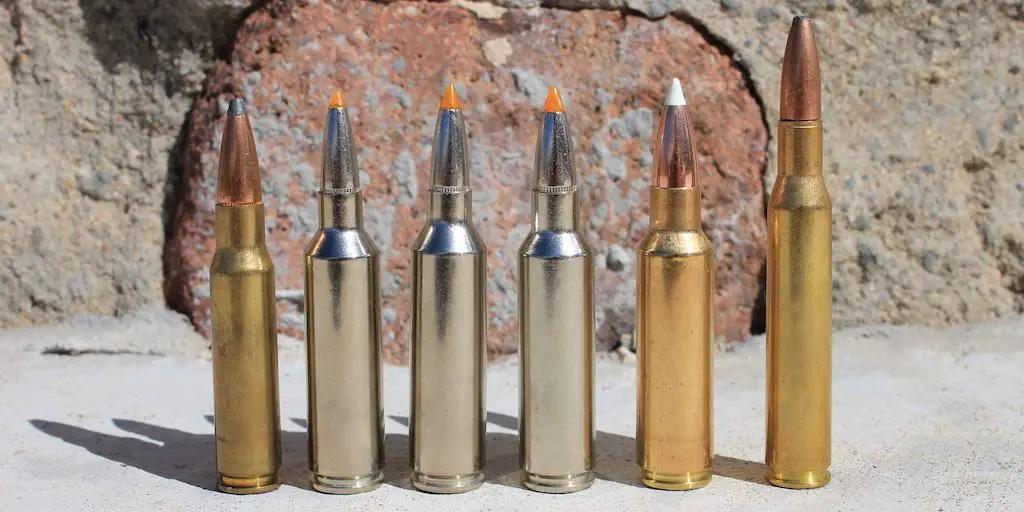
The modern “magnum era” began in earnest with the introduction of the 7mm Remington Magnum and .300 Winchester Magnum cartridges during the 1960s. Both cartridges use cases derived from the long, belted .375 H&H Magnum.
However, the Winchester Short Magnum cartridges all use a much fatter case without a belt that more closely resembles the case used by the old .404 Jeffery as well as the later Winchester Super Short Magnum (WSSM) line of cartridges.
The WSM cases all have a .535″ rebated rim that’s compatible with a standard magnum size bolt face. However, their .555″ case diameter is larger than those used by the 7mm Rem Mag and .300 Win Mag (.513″) as well as the .270 Winchester (.470″). Additionally, the Winchester Short Magnum Cartridges all have a case with very minimal taper and a 35 degree shoulder.
Taken together, these factors all maximize the case capacity of the WSM cartridges, even though their overall length of 2.86″ is still short enough to fit in the most popular short-action rifle models.
Proponents of the WSM cartridges also argue that this results in a shorter and wider powder column that’s more quickly ignited by the primer and burns more evenly than a comparable amount of powder in a longer and more narrow column. In theory, this results in improved accuracy for the shorter case.
Winchester made a big splash with the .300 Winchester Short Magnum in 2001 and followed up with the .270 Winchester Short Magnum cartridge in 2002.
Similar to the case with the other WSM cartridges, the 270 Winchester Short Magnum was designed and marketed specifically as short action alternative to an extremely popular and effective standard length cartridge: the .270 Winchester.
Designed by necking down a .30-06 case to use .277″ instead of .308″ bullets, the original .270 Winchester load shot a 130 grain bullet at approximately 3,140 feet per second (2,846 ft-lbs of energy). Originally released with the Winchester Model 54 rifle, the cartridge developed a well-deserved reputation for effectiveness on thin-skinned game over the years.
The cartridge understandably developed a large and devoted following during the course of the 20th Century and the .270 caliber became forever linked to the Winchester brand.
Though nowhere near as popular as the 270 Winchester, the 270 WSM was also well received by the hunting community.
Since it had a slightly larger case capacity, the 270 WSM shot the same diameter and weight bullets as the old 270 Winchester 200-300fps faster. Additionally, it achieved that level of performance in a much shorter package that fit in a short action rifle.
While that additional velocity resulted in a flatter trajectory, more resistance to wind drift, and more retained energy at longer ranges, Winchester used the same 1:10″ rifling twist rate as the 270 Winchester.
This twist rate worked extremely well for the 130gr-150gr bullet weight range the 270 and 270 WSM cartridges were originally developed for.
Those bullets are extremely effective for many hunting applications, but they don’t quite offer the sort of the extended performance more and more hunters and shooters are looking for these days. Shooters and hunters have started to place a much higher emphasis on long, heavy, and aerodynamic projectiles in recent years with the rise in popularity of long range shooting.
We’ll talk more about this in a second, but the point here is to realize that the 270 WSM definitely offered improved performance over the 270 Winchester and did so in a short action rifle, but that rifling twist rate hamstrung the cartridge to a certain degree.
Well, shooters in the 21st Century lamented the relatively few choices for high BC hunting bullets available in .277″ caliber.
In response, the various ammunition manufacturers have worked to satisfy that demand with offerings using sleek, low drag bullets. The Nosler AccuBond Long Range, the Barnes LRX, the Hornady ELD-X, and the various Berger bullets are all great examples of extremely aerodynamic hunting projectiles that have really taken off in recent years.
Unfortunately, those slower rifling twist rates used by the .270 Winchester and 270 WSM hampered development of long, heavy, low-drag bullets in .277″ caliber.
For example, there are several different hunting bullet options available in 6.5mm, 7mm, and .30 caliber with a G1 ballistic coefficient over .600 like the 143gr ELD-X in 6.5mm (.625 BC), the 168gr VLD Hunting in 7mm (.618 BC), and the 210gr AccuBond Long Range in .30 caliber (.661 BC).
Comparable bullets in .277″ caliber include the 145gr ELD-X (.536 BC), 150gr VLD Hunting (.518 BC), and the 150gr AccuBond Long Range (.591 BC).
True, hunters using custom rifles with a faster twist rate can use some of the very heavy and extremely aerodynamic 277″ caliber bullets that are available these days like the 170gr Berger Extreme Outer Limits (EOL) with a .662 BC. Those heavy bullets simply weren’t an option for hunters who don’t handload and who use factory production rifles though.
That changed in 2020 when Nosler rolled out their new 27 Nosler cartridge.
Designed from the beginning to use the new .277″ caliber 165gr AccuBond Long Range (.620 BC), 27 Nosler rifles used a faster 1:8.5″ rifling twist rate and took the performance of the .277″ caliber to the next level by allowing for the use of extremely high BC bullets in a .277″ caliber cartridge.
The Nosler cartridges are true fire breathing magnums that fire bullets with higher ballistic coefficients at very fast velocities, but they’re still fairly niche offerings and are primarily available in custom rifle builds (with a handful of exceptions).
This development set things in motion for the next domino to fall though.
That domino fell on 15 January 2021 when Browning and Winchester announced the release of the new 6.8 Western cartridge. Also known as the 6.8 Winchester Western, the announcement of the new round took some by surprise.
Instead of just revamping an older cartridge to use heavier bullets, designers at Winchester and Browning decided from the very beginning to build a purpose built cartridge that will outperform the old .270 Winchester and 270 WSM.
Basically, they wanted a new .277″ cartridge that offered magnum performance with very high BC bullets that would also fit in a short action rifle.
Here’s what Winchester’s lead engineer for the 6.8 Western, Kyle Masinelli, had to say:
We wanted to get into the untapped potential of bullets above the .264 caliber. We only wanted bullets with G1 BCs above .600 and our goal was to beat the .300 Winchester Magnum’s 180-grain AccuBond’s energy delivery at 500 yards.
To that end, they borrowed a page out of the playbook used in other successful cartridge releases like the 6.5 PRC. Similar in appearance to the 270 WSM and 6.5 PRC, the 6.8 Western has an overall length of 2.955″ and uses a beltless case that’s 2.02″ long, .535″ in diameter at the base, and has a 35 degree shoulder.
Though the 270 WSM cartridge has an overall length of 2.86″ and fits neatly into the traditional definition of a short action cartridge, the 6.8 Western exceeds those standards by a hair with a maximum cartridge overall length (COAL) of 2.955″. Even so, the 6.8 Western will feed reliably from short action AICS-pattern box magazines that are so common with modern rifles.
In addition to lengthening the COAL of the 6.8 Western, designers at Winchester moved the cartridge shoulder back slightly and decreased the case length compared to the 270 WSM. Similar to what designers at Hornady did with the 300 PRC, this resulted in a little bit more space for the bullet outside the case (also known as head height).
This facilitated the use of long, heavy-for-caliber bullets without requiring them to be seated too deeply into the case that they intrude into the powder column.
Those longer bullets also required a faster rifling twist rate for proper stabilization in flight. So, designers at Winchester and Browning designed the 6.8 Western for use in rifles with a 1:7.5″ or 1:8″ rifling twist rate (1:8″ is SAAMI standard).
The end result is a short and handy .277 caliber cartridge that delivers impressive ballistics that compare very favorably to some noted long range-cartridges.
You can learn more about the 6.8 Western and how the new caliber compares to other cartridges like the 6.5 PRC, 270 Winchester, 7mm Remington Magnum, and 28 Nosler in the articles below:
6.8 Western: The Ultimate Guide To What You Need To Know
6.8 Western vs 7mm Rem Mag vs 28 Nosler Comparison
Now let’s shift gears for a minute and talk about the development of the 6.5 Creedmoor.
Dave Emary of Hornady Manufacturing and Dennis DeMille of Creedmoor Sports saw an opportunity to build a new cartridge for high power rifle competition shooting in the early 2000s.
Specifically, they wanted to build an ideal long range shooting cartridge that would fit in a short action rifle and was still just as accurate as the .308 Winchester at long distance. However, the catch was they wanted the new cartridge to have less recoil, less wind drift, and a flatter trajectory.
By modifying a .30 Thompson Center (.30 TC) case to shoot .264″ bullets, they successfully built a cartridge optimized for use with 4350 class propellants with a relatively large case capacity that could also accommodate long, heavy, high ballistic coefficient (BC) bullets without intruding into the powder column.
Named the 6.5 Creedmoor (sometimes misspelled Creedmoore or Creedmore) in honor of the Creedmoor Matches and designed for use with a relatively fast 1:8″ rifling twist rate, Emary and DeMille were quite successful in their goal of building the ideal competition shooting cartridge with a relatively flat trajectory.
A typical 6.5 Creedmoor load shoots a 140-grain bullet at about 2,700 fps (2,266 ft-lbs). So, the 6.5 Creedmoor does not have eye popping ballistics, but it is very accurate, uses high BC bullets that retain energy and resist wind drift exceptionally well, and has moderate recoil.
For those reasons, the cartridge has seen a great deal of success in the hands of competition shooters and recently made the jump into the mainstream hunting community. The 6.5 Creedmoor cartridge has become extremely popular among hunters and shooters who appreciate the mild recoil and great extended range performance of the cartridge in recent years as well.
If you’d like to learn more about how the 6.5 Creedmoor compares to the .308 Winchester in more detail, read the article below:
6.5 Creedmoor vs 308 Winchester Debate Settled
6.8 Western vs 270 Winchester Short Magnum vs 6.5 Creedmoor Cartridge Sizes
You can see similarities and differences between the 6.8 Western, 270 WSM, and the 6.5 Creedmoor in the photos below.
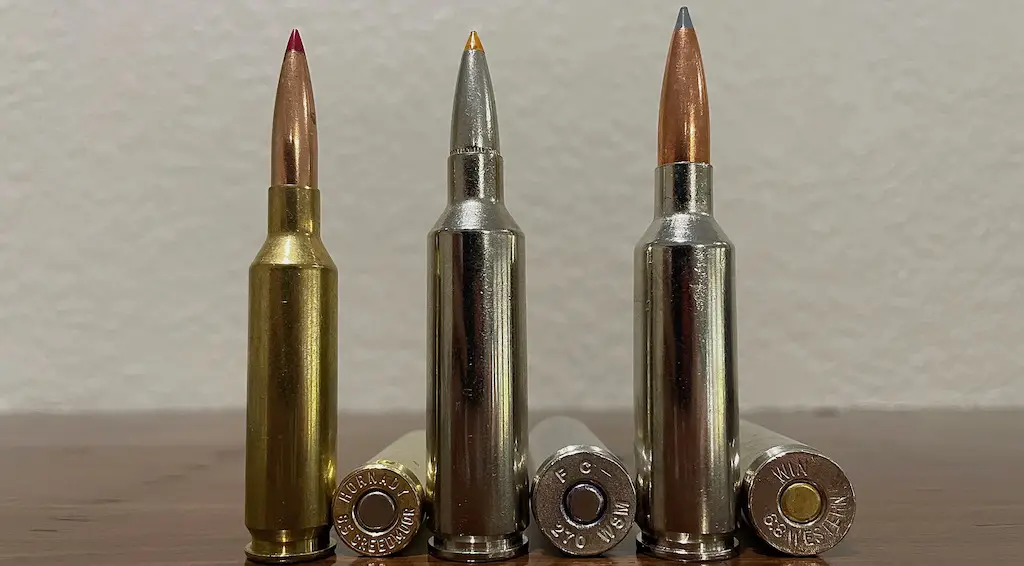
First, the 6.5 Creedmoor uses .264″ bullets while the 6.8 Western and .270 Winchester Short Magnum use .277″ bullets.
Additionally, they all use different weight bullets.
While the 6.5 Creedmoor can use lighter 120gr, 127gr, and 130gr bullets, it’s most commonly used with 140gr, 143gr, or 147gr bullets.
The 270 Winchester Short Magnum most often uses bullets in the 110-150 grain range, with 130 grain, 150 grain, and to a lesser extent, 140 grain bullets being the most common.
Finally, the 6.8 Western can use the same lighter weight 130-grain and 150-grain bullets as the .270 Winchester Short Magnum, but it’s optimized for 165 grain, 170 grain, and 175 grain bullets.
Everything else being equal, the heavier .277″ bullets used by the 6.8 Western have a higher ballistic coefficient and a higher sectional density than the lighter bullets of the same diameter from the 270 WSM. We’ll dive more into the nuts and bolts of exactly what this means in practical terms for these cartridges later in this article.
All three cartridges are similar in overall length.
Though the 6.8 Western has a maximum cartridge overall length (COAL) of 2.955″ that exceeds the traditional definition of a short-action rifle cartridge of 2.86″ long by a hair, the cartridge will feed reliably from short action AICS-pattern box magazines that are so common with modern rifles.
The 6.5 Creedmoor and 270 WSM are a tiny bit shorter with maximum overall lengths of 2.825″ and 2.86″ respectively.
Additionally, the 270 WSM has the longest case length of the three at 2.1″, while the 6.8 Western and 6.5 Creedmoor are a little shorter with 2.02″ and 1.92″ long cases respectively.
This all makes sense as the 270 Winchester Short Magnum, 6.5 Creedmoor, and 6.8 Western are all considered short action cartridges.
The 6.5 Creedmoor has a .473″ rim diameter while the 270 WSM and 6.8 Western have larger .535″ rim diameters.
Additionally, the 6.5 Creedmoor has a 30 degree shoulder angle while the 270 WSM and 6.8 Western each have a steeper 35 degree shoulder angle.
Not surprisingly, the 6.5 Creedmoor has the smallest case capacity of the three. While the 6.8 Western and 270 Winchester Short Magnum have very similar case capacities, the 270 WSM actually has a little bit more case capacity since it’s a little longer.
The 6.8 Western and 270 WSM are also loaded to a higher pressure than the 6.5 Creedmoor (65,000psi vs 62,000psi).
Note: while the powder capacity figures listed below do give a good indication of the differences between the two cartridges, exact case capacities vary slightly according to the brand of brass used.
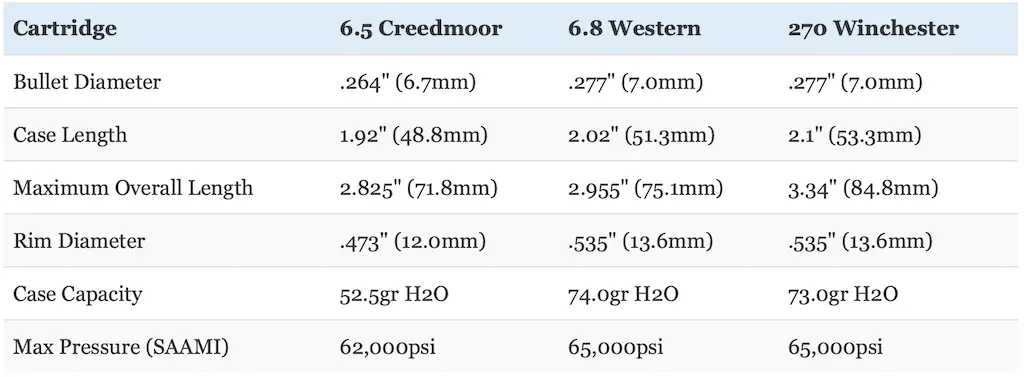
270 WSM vs 6.5 Creedmoor vs 6.8 Western Ballistics
As you can probably imagine, the differences in the external dimensions of these cartridges also translate into some important differences in their ballistic performance. This is illustrated in the table below comparing Winchester Expedition Big Game Long Range, Winchester Ballistic Silvertip, and Nosler Trophy Grande Long Range factory ammunition.
Specifically, the 6.8 Western loads are from the Winchester Expedition Big Game Long Range and Winchester Ballistic Silvertip Line and use 165gr AccuBond Long Range (.620 BC) and 170gr Ballistic Silvertip (.563 BC) bullets.
The 270 WSM loads are from the Nosler Trophy Grade Long Range and Winchester Ballistic Silvertip lines and use 150gr Nosler AccuBond Long Range (.591 BC), 150gr Ballistic Silvertip (.496 BC), and 130gr Ballistic Silvertip (.432 BC) bullets.
The 6.5 Creedmoor loads are from the Winchester Expedition Big Game Long Range and Winchester Ballistic Silvertip Line and use 142gr AccuBond Long Range (.625 BC) and 140gr Ballistic Silvertip (.509 BC) bullets.
Even though those factory loads are from two different companies, this is still an “apples to apples” comparison because all those loads all use bullets that are virtually identical. The Winchester Expedition Big Game Long Range factory loads use Nosler bullets that have the same BC and are otherwise identically constructed as the bullets used in Nosler Trophy Grade Long Range factory loads.
All seven loads used a 200 yard zero.
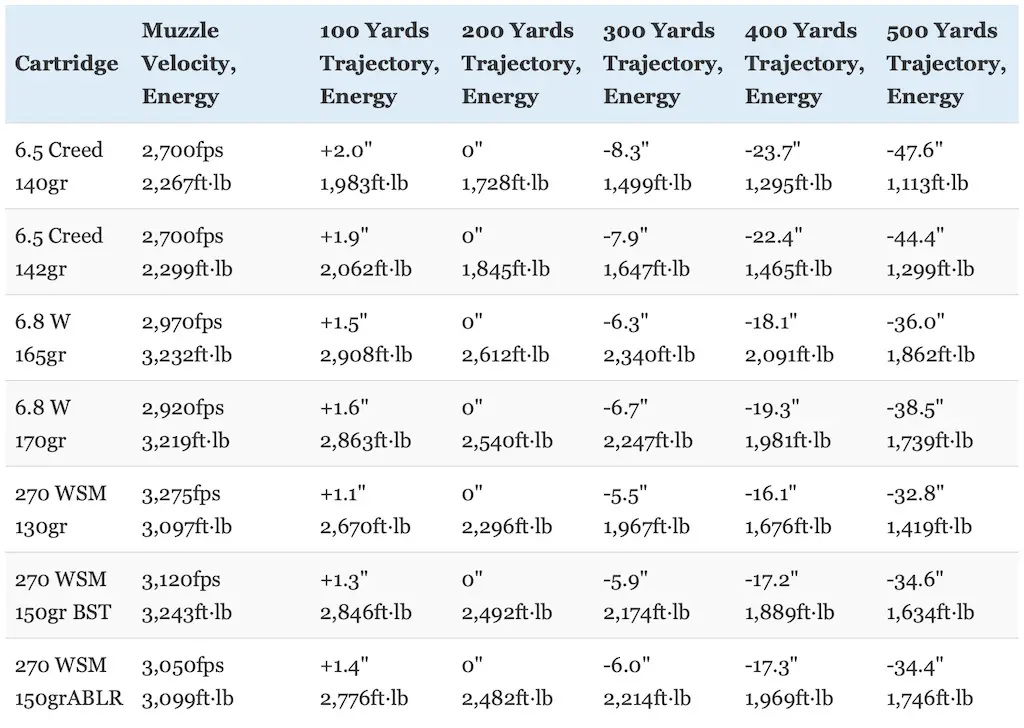
As you can see, all three 27Winchester Short Magnum loads have a flatter trajectory than both 6.8 Western loads. The difference between them is small and they’re only separated by a couple of inches at 500 yards, but the 270 WSM has a definite edge here.
Even though the 6.8 Western uses more aerodynamic bullets, the 270 WSM has the edge in this area because these 270 WSM loads have a faster muzzle velocity (80-355fps depending on the exact load).
On the other hand, the 6.8 Western has the edge with retained kinetic energy. That 150gr 270 WSM Ballistic Silvertip load actually has a tiny bit more muzzle energy (owing to its higher muzzle velocity), but the 165gr 6.8 Western load surpasses it inside 100 yards. Since that 6.8 Western load uses a more aerodynamic bullet, that gap grows in favor of the 6.8 Western as range increases.
The 270 WSM load shooting the 150gr AccuBond Long Range has almost exactly the same amount of kinetic energy as the 6.8 Western Ballistic SilverTip load at 500 yards. Aside from that, the 6.8 Western has the edge.
That advantage ranges from 6% to 31% more energy at 500 yards.
So, the 270 WSM and 6.8 Western are extremely similar in these areas. Especially when comparing those AccuBond Long Range loads, the 6.8 Western has a small advantage in kinetic energy while the 270 WSM has the advantage in trajectory.
At the same time, both the 270 WSM and 6.8 Western handily surpass the 6.5 Creedmoor in performance with both trajectory and retained energy. Both 6.5 Creedmoor loads have between 6″ and 15″ more bullet drop and 9-67% less kinetic energy than the 6.8 Western and 270 WSM at 500 yards.
Indeed, the 165gr ABLR load from the 6.8 Western has more energy at 300 yards than either 6.5 Creedmoor load has at the muzzle.
That shouldn’t be too surprising though. After all, the 270 WSM and 6.8 Western are short action magnum cartridges while the 6.5 Creedmoor is a sweet shooting target round that’s also suitable for hunting.
The chart below compares how much a 10 mile per hour crosswind impacts those same 6.8 Western, 270 WSM, and 6.5 Creedmoor loads out to 500 yards.
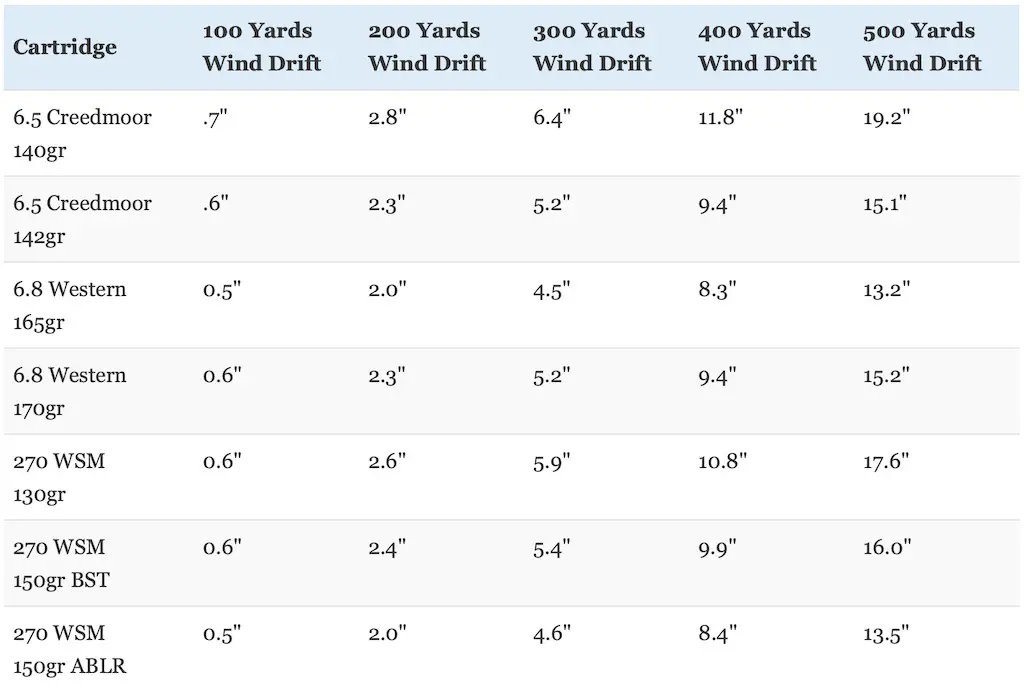
This is one of those areas where the 6.8 Western shines.
As you can see, while that 150gr 270 WSM ABLR load is right there with the 165gr ABLR from the 6.8 Western, both 6.8 Western loads offer better resistance to wind deflection than the other 270 WSM loads and the 6.5 Creedmoor Ballistic Silvertip load.
Interestingly, the extremely aerodynamic 6.5 Creedmoor ABLR load essentially duplicates the performance of the 170gr 6.8 Western Ballistic Silvertip load and also edges both of the 270 WSM Ballistic Silvertip loads.
All things considered, the 6.8 Western ABLR has an advantage over the 270 WSM and the 6.5 Creedmoor in terms of wind deflection at 500 yards.
The details vary depending on the exact load, but it varies from .3-4.4″ (2-33%) less wind deflection for the 6.8 Western vs the 270 WSM and 1.1-6″ (9-45%) less wind deflection for the 6.8 Western vs 6.5 Creedmoor.
The differences are of course smaller at shorter range.
Now let’s talk about recoil.
The table below compares the recoil produced by handloads that approximate the performance of the factory loads above firing the Nosler AccuBond Long Range for each cartridge when fired from identical 7 pound rifles.
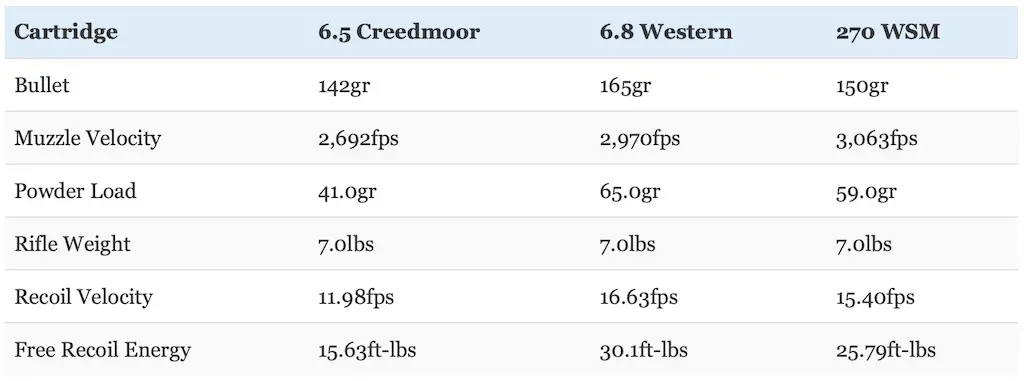
Felt recoil will vary from shooter to shooter and rifle to rifle, but free recoil energy is still a useful way to compare cartridges.
This is where things gets especially interesting.
First, the 6.5 Creedmoor really runs away with things here. While it definitely lags behind the others in terms of trajectory, kinetic energy, and wind deflection (though less so with wind deflection), it also has quite a bit less recoil than the 6.8 Western and 270 WSM.
Now, that 6.8 Western 165gr ABLR load performs really well, but it also produces about 17% more recoil than the 270 WSM 150gr ABLR load.
This is because it’s using more powder to push a heavier bullet.
Now, even the 6.8 Western doesn’t have a ridiculous amount of recoil. The recoil produced by this particular load is definitely more than the 6.5 Creedmoor and 270 WSM, but it’s also not so excessive that it’s impossible to shoot.
Indeed the 6.8 Western still recoils less than the 300 Win Mag and the 7mm Rem Mag.
The recoil of the 6.8 Western can be further mitigated to a certain extent with the use of a suppressor, muzzle brake, or a good recoil pad. So the extra recoil of the cartridge isn’t necessarily a deal breaker for many people.
It’s still worth considering though and this is an advantage in favor of the 6.5 Creedmoor and 270 WSM.
Don’t underestimate the impact that recoil has on the ability of a person to shoot accurately either. Some people do handle recoil better than others, but all other things being equal, they will absolutely shoot more accurately with a milder recoiling cartridge.
Additionally, there are a couple of other factors that are also worth discussing in the 6.8 Western vs 6.5 Creedmoor vs 270 WSM debate.
First, the 270 WSM and 6.8 Western use larger diameter bullets than the 6.5 Creedmoor.
Specifically, the larger diameter .277″ bullets used by those cartridges have about 10% more frontal surface area (also known as cross sectional area) than the .264″ bullets used by the 6.5 Creedmoor (.0603 vs .0547 square inches). All other things being equal, a bigger bullet will make a bigger hole, cause more tissue damage, and result in more blood loss.
This is a small advantage in favor of the 6.8 Western and 270 WSM.
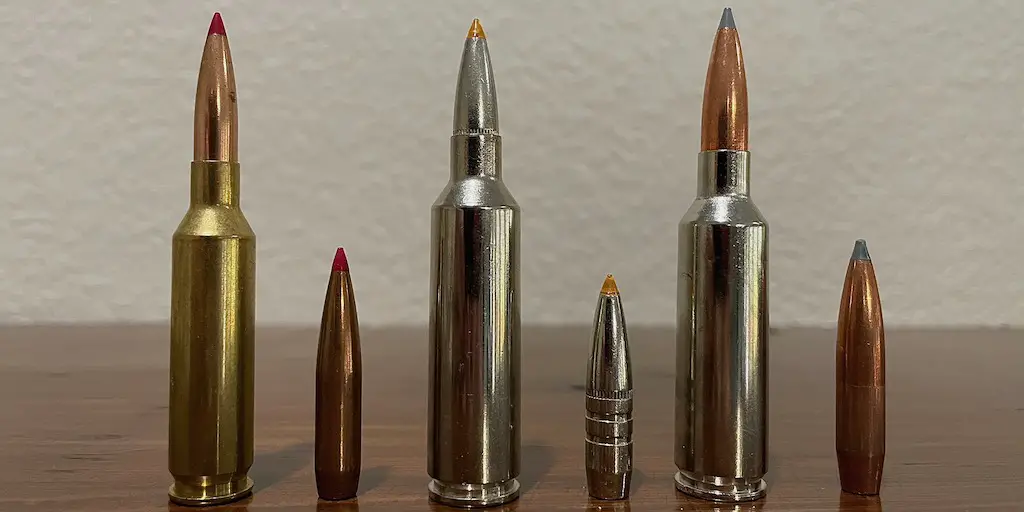
Especially when combined with the fact that the two cartridges carry more kinetic energy downrange, those larger diameter bullets can also be helpful when hunting big game.
On the other hand, as we covered earlier, those longer, heavy for caliber .277″ bullets the 6.8 Western is optimized for have a higher ballistic coefficient than the most common bullets used in the 270 WSM. The 6.5 Creedmoor is no slouch in this area either though.
There’s a bit of overlap here though.
For instance, the .277″ 165gr AccuBond Long Range used by the 6.8 Western has a BC of .620. This definitely higher than the 150gr AccuBond Long Range used by the 270 WSM, which has a BC of .591.
On the other hand, the .264″ 142gr AccuBond Long Range used by the 6.5 Creedmoor has a BC of .625. The same goes for the 143gr Hornady ELD-X.
While those differences are indeed small in favor of the 6.8 Western over the 270 WSM and the 6.5 Creedmoor over the 6.8 Western, they are still worth considering because those slightly more aerodynamic projectiles don’t slow down as fast and are more resistant to wind drift.
Those bullets also have a relatively high sectional density (SD).
Sectional density (SD) is a measure of the ratio of the diameter of a projectile to its mass. All other things equal, a heavier projectile of a given caliber will be longer and therefore have a higher sectional density and consequently penetrate deeper than projectiles with a lower mass and sectional density.
130 grain, 150 grain, 165 grain, and 170 grain .277″ bullets have sectional densities of .242, .279, .307, and .317 respectively. At the same time, 130 grain, 140 grain, 142 grain, and 143 grain .264″ bullets have sectional densities of .266, .287, .291, and .293.
So, the 6.8 Western has a definite edge in sectional density compared to the 270 WSM and a slightly smaller advantage over 6.5 Creedmoor with the most commonly available hunting bullets in factory loads. At the same time, the heavy for caliber 140-143gr .264″ bullets have a definite edge over the 130-150gr bullets used by the 270 WSM in sectional density.
So, the high SD bullets used by the 6.5 Creedmoor assist with penetration to help the cartridge “punch above its weight” in a manner similar to the 7x57mm or 9.3x62mm Mauser cartridges.
The same is definitely true for the 6.8 Western as well.
What about 6.8 Western vs 6.5 Creedmoor vs 270 WSM accuracy?
All three are certainly capable of outstanding accuracy (often sub-MOA) in the right hands and in good rifles.
It’s really hard to pick a winner here.
On one hand, certain 270 WSM loads have great ballistics on paper, which can help the shooter battle environmental conditions and effectively place rounds on target.
On the other hand, the on paper ballistic performance 6.8 Western lags just a little behind the 270 WSM in terms of trajectory while also having more recoil, but it also performs a tiny bit better in the wind.
Additionally, the 6.5 Creedmoor was specifically designed as a competition shooting cartridge. At the same time, since it utilizes .264″ bullets, there is a bigger selection of high BC and high SD match grade hunting bullets available for the cartridge.
Finally, 6.8 Western and 6.5 Creedmoor both have a smaller freebore diameter than the .270 WSM.
Freebore is the smooth portion of a rifle barrel closest to the cartridge. Having a more snug freebore diameter means there’s less room for the bullet to yaw upon firing before engaging the rifling. This can also help enhance accuracy.
The 6.5 Creedmoor and 6.8 Western have a minuscule .0001″ of freebore diameter compared to .0003″ for the 270 WSM.
Yes, the 270 WSM has literally 3x as much space around the bullet when a cartridge is chambered. The tight freebore of the 6.5 Creedmoor and 6.8 Western keeps the bullet straight prior to engraving the rifling, which enhances accuracy.
That’s not to say the 270 WSM isn’t capable of great accuracy (because it certainly can be).
However, that’s another potential advantage the 6.5 Creedmoor and 6.8 Western have here.
So like I said, it’s tough to pick a winner here. My first inclination would be to rank the 6.5 Creedmoor first, followed by the 6.8 Western, and then finally the 270 WSM.
However, the details will vary on the exact rifle, ammunition, and shooter in question.
So where do we stand with these cartridges?
6.8 Western vs 6.5 Creedmoor
The 6.8 Western fires larger diameter and heavier bullets at a faster velocity than the 6.5 Creedmoor. This translates into the 6.8 Western having a flatter trajectory, more resistance to wind drift, and more retained kinetic energy downrange, but more recoil than the 6.5 Creedmoor.
6.8 Western vs 270 WSM
Both cartridges fire the same diameter bullets, but the 6.8 Western is capable of firing heavier and more aerodynamic bullets. However, 270 WSM factory loads typically have a faster muzzle velocity. So, the 270 WSM has a flatter trajectory and less recoil, but the 6.8 Western retains more energy at longer range and has more resistance to wind drift.
6.5 Creedmoor vs 270 WSM
The 270 WSM fires larger diameter and heavier bullets at a significantly faster velocity than the 6.5 Creedmoor. The 270 WSM recoils more than typical 6.5 Creedmoor loads, but will also have more retained kinetic energy, a flatter trajectory, and more resistance to wind drift.
270 WSM vs 6.8 Western vs 6.5 Creedmoor Ammo
The 6.5 Creedmoor in particular is an extremely popular centerfire rifle cartridge. In fact, it’s one of the most popular cartridges in use in North America.
For that reason (during normal times) ammo is usually easiest to find for the 6.5 Creedmoor. In general, 6.5 Creedmoor ammo is typically the least expensive of the 3 as well.
The big ammunition manufacturers like Barnes, Berger, Browning, Federal Premium, Hornady, HSM, Nosler, Remington, Sierra, Sig Sauer, Swift, and Winchester all produce an incredible variety of ammo for the 6.5 Creedmoor in most of their really popular lines of ammo.
This includes almost everything from “plain Jane” ammo like the Remington Core Lokt and Winchester Super X lines to more specialized ammo like the Hornady Precision Hunter and Federal Terminal Ascent Lines.
While I wouldn’t say it’s exactly rare, the 270 WSM is the most difficult to find right now.
As of early 2022, 270 WSM is available in a good number of loadings from most of the big companies like Barnes, Browning, Federal, Hornady, Nosler, Remington, and Winchester. Most of the popular ammo lines are available as well.
With all that said, it has been fairly difficult to come by during the ongoing 2020-2022 ammo shortage.
At this instant, the Winchester Expedition Big Game Long Range line loaded with 165gr Nosler AccuBond Long Range bullets, the Browning Long Range Pro Hunter line loaded with 175gr Sierra GameChanger bullets, the Winchester Ballistic SilverTip line loaded with 170gr Ballistic SilverTip bullets, and the Winchester Copper Impact line loaded with 162gr Copper Impact bullets are the only loaded ammo options I’m aware of for the 6.8 Western cartridge.
There is a surprisingly good selection of factory loaded 6.8 Western ammunition these days. At this time, Browning and Winchester are the primary sources of factory 6.8 ammo, but it’s usually not too hard to find ammo for the cartridge as of early 2022.
Ammo availability is also usually excellent online and the bigger retailers typically have a good selection of quality factory ammo for both cartridges as well.
BUY SOME GREAT 6.5 CREEDMOOR AMMO HERE
BUY SOME GREAT 6.8 WESTERN AMMO HERE
BUY SOME EXCELLENT 270 WSM AMMO HERE
If you’d like to learn more about some of the various hunting ammunition choices for the 6.8 Western and 6.5 Creedmoor cartridges, read these articles:
Best 6.5 Creedmoor Ammo For Hunting Elk & Deer
Best 6.8 Western Ammo For Hunting Elk, Deer, & Bear
Handloaders will appreciate the fact that reloading components for all 3 cartridges available and there’s an pretty good variety of bullet choices for each cartridge (especially the 6.5 Creedmoor). So, you should not have any trouble working up a good custom load for either one if you like to handload.
The 6.5 Creedmoor shoot the same .264″ bullet size that’s also used by the 6.5 Grendel, 260 Remington, the 6.5×55 Swede, and the 264 Winchester Magnum (among others).
The 6.8 Western uses the same .277″ bullet size as the .270 Winchester, the 6.8 Remington SPC, and the 270 Weatherby. While those Winchester and Weatherby cartridges in particular use a slower rifling twist rate than the 6.8 Western, the 6.8 Western cartridge will readily shoot those lighter 130-150gr bullets most commonly used in those chamberings without issue.
Bullets like the Barnes LRX, TSX, and TTSX, the Berger VLD and Hybrid Hunter, the Hornady ELD-X, GMX, InterBond, InterLock, SST, and V-Max, the Nosler AccuBond, Ballistic Tip, E-Tip, and Partition, the Sierra GameChanger and GameKing, the Swift Scirocco and A-Frame, (just to name a few) are options for if you want to reload the 6.5 Creedmoor, the 270 WSM, and the 6.8 Western.
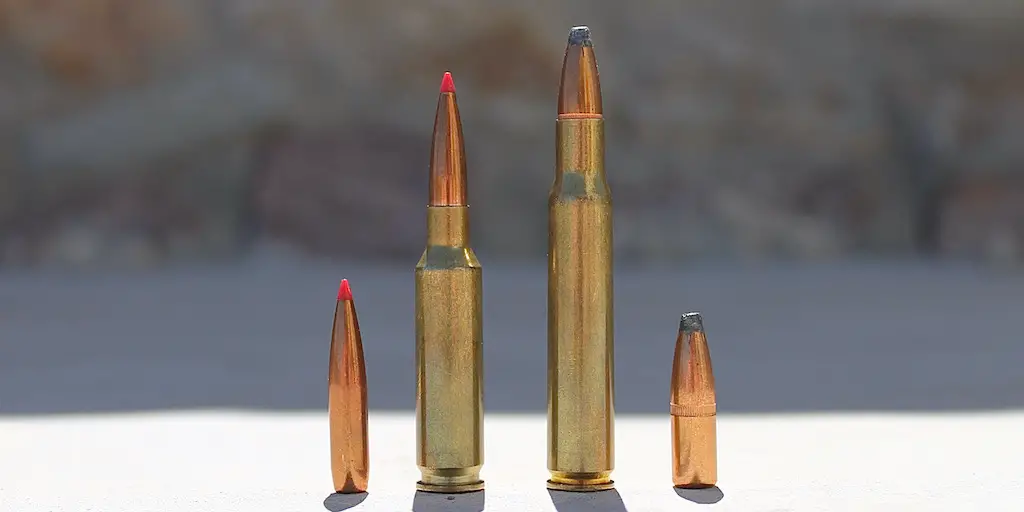
270 WSM vs 6.8 Western vs 6.5 Creedmoor Rifles
The rifle situation with the 6.8 Western, 6.5 Creedmoor, and 270 WSM is similar to the ammunition situation.
Of the 3, the 6.5 Creedmoor is the most popular and is extremely common in bolt-action rifles. In fact, just about every really popular bolt-action hunting rifle in current production is available in 6.5 Creedmoor
For instance, both the 6.5 Creedmoor is available in several different versions of the Remington Model 700 and Winchester Model 70. The same goes for the Browning X-Bolt, Kimber Hunter, Mossberg Patriot, Nosler M48, Ruger American, Ruger Hawkeye, Savage Axis, Savage 110, Tikka T3x, Weatherby Vanguard, and Winchester XPR.
Things are a little different with the 270 WSM though, which is primarily available offerings from Browning and Winchester like the X-Bolt, AB3, Model 70, and XPR. Savage also produces their 110 rifle in 270 WSM.
At this time, Browning and Winchester are the only major manufacturers producing rifles in 6.8 Western.
However, there’s a pretty good selection of 6.8 Western rifles available from both companies. As of early 2022, 6.8 Western rifles include 21 different versions of the Browning X-Bolt, 14 versions of the Winchester XPR, and 9 versions of the Winchester Model 70 bolt action rifles.
During normal times, the 6.5 Creedmoor is by far the most common and easiest to find. The same goes with finding 6.5 Creedmoor rifles that are less expensive.
However, as of early 2022, we’re still not living in normal times.
The 6.8 Western was first released during the middle of the big ammo shortage in early 2021, which actually meant that rifles in that chambering were fairly easy to come by until the last couple months of the year.
Most of those examples were snapped up by November or December though.
As I write this article in May of 2022, 6.5 Creedmoor rifles appear to be the most common on dealer’s shelves, followed by the 6.8 Western and then the 270 WSM.
It’s also important to realize that gun manufacturers tend to put longer barrels on rifles chambered in magnum cartridges in general. This is because those cartridges need a longer barrel to effectively and efficiently burn that larger powder charge.
Barrel lengths do vary depending on the manufacturer and exact model.
However, the 6.8 Western is normally available in rifles with a 24″ barrel, though some models have 26″ barrels. A handful of models have shorter 22″, 20″ or even 16.5″ barrels in some cases (though those shorter barrels are somewhat unusual and are most common on “suppressor ready” models).
24″ barrels are pretty standard with the 270 WSM, though it’s possible to find rifles with 22″ or even those 16.5″ barrels (once again, in “suppressor ready” models).
Things are a little different with the 6.5 Creedmoor, which is most common with a 22″ barrel. 24″ long barrels are not unusual though. Neither are 20″ or even shorter barrels.
All things considered, rifles chambered in 270 WSM and 6.8 Western tend to be slightly longer, heavier, and more unwieldy than rifles chambered in 6.5 Creedmoor.
Having a shorter and lighter rifle is more important on some hunts than on others. So, just keep that in mind.
BUY A GREAT 6.8 WESTERN RIFLE HERE
BUY A GREAT 6.5 CREEDMOOR RIFLE HERE
If you’d like to learn more about some of the various hunting rifle choices for the 6.5 Creedmoor and 6.8 Western cartridges, read these articles:
Best 6.5 Creedmoor Hunting Rifles
Best 6.8 Western Hunting Rifles
6.8 Western vs 6.5 Creedmoor vs 270 WSM: Which Is Right For You?
Do you primarily hunt medium sized game like whitetail deer, feral hogs, or black bear at ranges within 200 yards? All three are extremely effective deer hunting cartridges and will absolutely get the job done on medium sized game if you do your part. There’s nothing wrong with using any of those cartridges on deer inside of 200 yards, but this is the perfect job for the 6.5 Creedmoor, which will be easier on both your shoulder and your wallet than the other two.
If you’re going to be hunting in thick brush or in the tight confines of a deer stand, remember what I just mentioned about the size difference with 6.5 Creedmoor vs 6.8 Western vs 270 Winchester Short Magnum rifles. That extra couple of inches in overall length of a rifle can be a real headache to deal with when trying to quickly and quietly maneuver for a shot. Of these cartridges, the 6.5 Creedmoor is definitely the better choice for a truly compact rifle with a shorter barrel.
Are you looking for the cartridge better suited for long range hunting for game like mule deer or pronghorn antelope in open country where you might need to take a shot at several hundred yards? Once again, they’ll all work really well in this role and situations. However, the 270 WSM and 6.8 Western definitely start to stand apart from the 6.5 Creedmoor here. Especially when using those 165gr AccuBond Long Range bullets, the 6.8 Western carries more energy out to extended range, but the 270 WSM is extremely effective in this role as well.
I’d lean towards the 6.8 Western if you want the best resistance to wind drift, but the difference between the 6.8 Western and 270 WSM is honestly pretty small. All things considered, I’d say the 270 WSM is actually the ideal cartridge for this sort of hunting and absolutely excels on deer sized game in open country.
Do you want a hunting cartridge that’s well suited for caribou, moose, elk, eland, kudu, or red stag hunting? While it will work on bigger game, I think the 6.5 Creedmoor is on the light side for this sort of hunting. The 270 WSM will certainly work in this area, especially if using a well constructed 150 grain bullet. However, I think the 6.8 Western is a better choice here because it carries a little more kinetic energy at extended range and can use heavier (and probably better penetrating bullets).
What about the 6.5 Creedmoor? Yes, you can hunt elk with it, but you need to be aware of a couple of things before you go down that road.
To that end, I recorded an entire podcast episode on elk hunting with the 6.5 Creedmoor with someone who has cleanly taken elk with the cartridge. Our discussion does a great job of covering the pros and cons of the 6.5 Creedmoor for elk hunting and anyone planning on going elk hunting in the future should definitely listen to this interview.
Just click the appropriate link below to listen to this episode on your preferred podcasting service. Be sure to hit that “subscribe” or “follow” button if you like the show!
6.5 Creedmoor For Elk Hunting Podcast
Apple | Google | iHeart | Spotify
Are you specifically hunting brown or grizzly bear? What if you hunt in Canada or Alaska and need a heavy hitting cartridge just in case you find yourself on the wrong end of a grizzly/brown bear attack? I do not recommend any of these cartridges for actually hunting the big bears, though they will work in a pinch. While I’d prefer to carry something heavier like a .300 Win Mag or a .338 Win Mag in grizzly country, I’d go with the 6.8 Western since it uses larger and heavier bullets than the 6.5 Creedmoor (and heavier bullets than the 270 WSM).
Are you sensitive to recoil and in need of a serious low recoil cartridge? The 6.5 Creedmoor wins here hands down and is definitely the lightest recoiling of the three with the 270 WSM edging the 6.8 Western out a bit in this area.
The 6.8 Western, 6.5 Creedmoor, and 270 Winchester Short Magnum are all excellent rifle cartridges. While the 6.8 Western is the latest flavor of the week and does offer certain advantages over the 270 WSM in some aspects, there’s still not a darn thing wrong with the 270 Winchester Short Mag either.
In many ways, the 6.8 Western is what the 270 WSM should have been from the beginning.
Likewise, while the 6.5 Creedmoor is a great choice for certain applications, it’s clearly outclassed by the 270 WSM and 6.8 Western in many other areas, especially for hunting bigger game and/or for longer range hunting situations.
Though the differences between them (6.8 Western vs 6.5 Creedmoor vs 270 WSM) are fairly significant in certain respects, they’re all suitable for many hunting tasks.
So, carefully analyze your potential needs before making a decision. In the end, a lot of this decision comes down to personal preference. So, choose the one that you feel most comfortable with and it will probably serve you well afield. Good luck!
NEXT: 308 vs 30-06 SPRINGFIELD vs 300 WIN MAG: WHICH SHOULD YOU HUNT WITH?
NEXT: 101 BEST GIFTS FOR HUNTERS
Enjoy this article comparing the 6.8 Western, 270 Winchester Short Magnum, and 6.5 Creedmoor cartridges? Please share it with your friends on Facebook and Twitter.
The Lyman 50th Edition (p183-184 and p199-200) and Hornady 10th Edition (p317-322 and 356-359) reloading manuals were used as references for the history of the cartridges. I obtained the data used to compare the trajectory of the cartridges from Nosler, and Winchester (here and here). Data used to calculate recoil was obtained from the Nosler 9th edition reloading manual (p268-276 & p443-450). Case capacity information for the 6.8 Western, 270 WSM, and 6.5 Creedmoor was obtained from Chuck Hawks (here and here) and The American Rifleman. Maximum pressure and data to compare cartridge sizes for the 6.8 Western, 270 WSM, and 6.5 Creedmoor were obtained from SAAMI (p23, p28, p39, and p86) and here. I used ShootersCalculator.com to compare trajectory and recoil for the cartridges.
Make sure you subscribe to The Big Game Hunting Podcast and follow The Big Game Hunting Blog on Facebook, Instagram, Twitter, and YouTube.
John McAdams is a proficient blogger, experienced shooter, and long time hunter who has pursued big game in 8 different countries on 3 separate continents. John graduated from the United States Military Academy at West Point and is a veteran of combat tours with the US Army in Iraq & Afghanistan. In addition to founding and writing for The Big Game Hunting Blog, John has written for outdoor publications like Bear Hunting Magazine, The Texas State Rifle Association newsletter, Texas Wildlife Magazine, & Wide Open Spaces. Learn more about John here, read some of John’s most popular articles, and be sure to subscribe to his show: the Big Game Hunting Podcast.

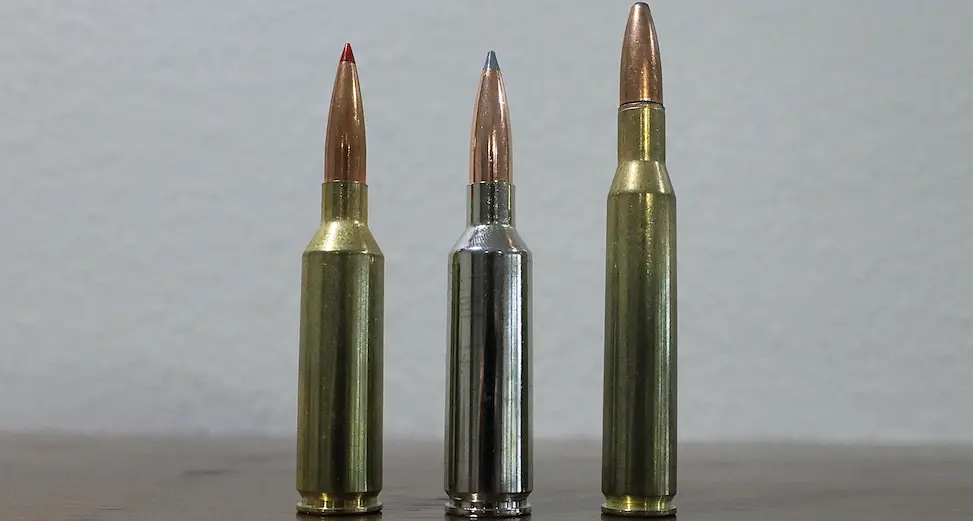

We need a 6.8 Western vs 300 Norma
Great read, thank you. I just purchased a Browning 6.8 because I can’t find ammo for my Browning 7mm WSM. I dearly love that 7mm WSM and have successfully hunted big game with it for 10 years. From what I recall, the 7mm WSM had slightly better performance parameters than the 270 WSM. Would be great to have a 270 WSM vs 7mm WSM vs 6.8 Western assessment.
Much like auto manufacturers, firearms producers must continuosly engineer “better” products sold with more effective marketing campaigns in order to meet financial goals. I routinely keep my trucks for 200K miles and have never felt inconvenienced or in need of a better truck and I own rifles as old as myself (70 yrs) and have never felt the need for the latest and greatest firearm. By sticking with the “tried and true” in both automotive and firearms choices, I have been able to keep more money to achieve my financial goals (early retirement, zero debt, millionaire status) while enjoying more time to hunt rather than to play with new guns or trucks. Bottom line is that the guns available to us for many decades are more than sufficient. All else is ego-driven nonsense by those who wish to separate all of us from our money.